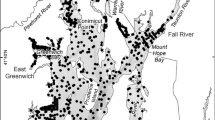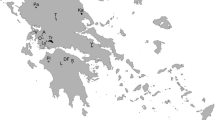Abstract
Taxonomic sufficiency has been used mainly to assess benthic condition, based on the assumption that taxa can be identified to a taxonomic level higher than the species level without losing the ability to detect changes related to pollution stress. Identifying taxa to a higher level reduces the expertise and time needed to identify organisms and consequently allows increased spatial and temporal replication. The usefulness of taxonomic sufficiency for typology (identification of water body types) was examined using the benthic communities of the Mondego River estuary (Portugal). Benthic samples were collected seasonally along the Northern branch of the Mondego River estuary from July 2000 to June 2001 and several environmental parameters were measured simultaneously. Cluster analysis of species data indicated three major ecological groups, mainly related to a saline gradient along the estuary. The same groups were found when taxa were aggregated to higher taxonomic levels (genus, family, order, class), except for the phylum level. The overall spatial pattern was driven by: (1) the dominance of bivalves and the occurrence of rare marine species in the Lower Estuary; (2) the dominance of polychaetes in the Middle Estuary; (3) and the dominance of arthropods in the Upper Estuary. The ability of different taxocenes to discriminate the three ecological groups was also examined. Mollusca and Bivalvia were the only taxocenes producing the same groupings, although other taxocenes (Annelida, Polychaeta, Spionidae, Arthropoda) showed a significant ability to discriminate between all three groups. Compared to using all taxa identified to the lowest possible taxonomic level, our results indicate that for typology (1) several higher taxonomic levels were sufficient (2) while few taxocenes alone were sufficient.






Similar content being viewed by others
References
Anonymous, 1959. Venice system. 1959. Final resolution of the symposium on the classification of brackish waters. Archivio di Oceanografia e Limnologia 11: 243–248.
Attrill, M. J. & S. D. Rundle, 2002. Ecotone or ecocline: ecological boundaries in estuaries. Estuarine, Coastal and Shelf Science 55: 929–936.
Baldó, F., S. F. García-Martín, P. Drake & A. M. Arias, 1999. Discrimination between disturbed coastal ecosystems by using macrobenthos at different taxonomic levels. Bolletín del Instituto Español de Oceanografía 15: 489–493.
Bianchi, C. N. & C. Morri, 2000. Marine biodiversity of the Mediterranean Sea: situation, problems and prospects for future research. Marine Pollution Bulletin 40: 367–376.
Blake, J. A. & P. L. Arnofsky, 1999. Reproduction and larval development of the spioniform Polychaeta with application to systematics and phylogeny. Hydrobiologia 402: 57–106.
Boesch, D. F., 1977a. Application of Numerical Classification in Ecological Investigations of Water Pollution. U. S. E. P. A., Corvallis, Oregon.
Boesch, D. F., 1977b. A New Look at the Zonation of the Benthos Along the Estuarine Gradient. In Coull, B. (ed.), Ecology of Marine Benthos. University of South Carolina Press, Columbia, 245–266.
Borja, A., J. Franco & V. Pérez, 2000. A marine biotic index to establish the ecological quality of soft bottom benthos within European estuarine and coastal environments. Marine Pollution Bulletin 40: 1100–1114.
Chainho, P., J. L. Costa, M. L. Chaves, M. F. Lane, D. M. Dauer & M. J. Costa, 2006. Seasonal and spatial patterns of distribution of subtidal benthic invertebrate communities in the Mondego River, Portugal: a poikilohaline estuary. Hydrobiologia 555: 59–74.
Clarke, K. R. & R. N. Gorley, 2001. PRIMER v5: user manual/tutorial. PRIMER-E. Plymouth Marine Laboratory Plymouth.
Clarke, K. R. & R. M. Warwick, 1994. Change in Marine Communities: an Approach to Statistical Analysis and Interpretation. Natural Environmental Research Council, Plymouth Marine Laboratory, Plymouth.
Dauer, D. M., C. A. Maybury & R. M. Ewing, 1981. Feeding behavior and general ecology of several spionid polychaetes from the Chesapeake Bay. Journal of Experimental Marine Biology and Ecology 54: 21–38.
Dauvin, J. C., J. L. Gomez Gesteira & M. S. Fraga, 2003. Taxonomic sufficiency: an overview of its use in the monitoring of sublittoral benthic communities after oil spills. Marine Pollution Bulletin 46: 552–555.
De Biasi, A. M., C. M. Bianchi & C. Morri, 2003. Analysis of macrobenthic communities at different taxonomic levels: an example from an estuarine environment in the Ligurian Sea (NW Mediterranean). Estuarine, Coastal and Shelf Science 58: 99–106.
Eaton L., 2000. Development and validation of biocriteria using benthic macroinvertebrates for North Carolina estuarine waters. Marine Pollution Bulletin 42: 23–30.
Ellis, D., 1985. Taxonomic sufficiency in pollution assessment. Marine Pollution Bulletin 16: 459 p.
Ferraro, S. P. & F. A. Cole, 1990. Taxonomic level and the sample size sufficient for assessing pollution impacts on the Southern California Bight macrobenthos. Marine Ecology Progress Series 67: 251–262.
Ferraro, S. P. & F. A. Cole, 1992. Taxonomic level sufficient for assessing a moderate impact on macrobenthic communities in Puget Sound, Washington, USA. Canadian Journal of Fisheries and Aquatic Sciences 49: 1184–1188.
Ferraro, S. P. & F. A. Cole, 1995. Taxonomic level sufficient for assessing pollution impacts on the Southern California Bight macrobenthos-revisited. Environmental Toxicology and Chemistry 14: 1031–1040.
Flindt, M. R., L. Kamp-Nielsen, J. C. Marques, M. A. Pardal, M. Bocci, G. Bendoricchio, J. Salomonsen, S. N. Nielsen & S. E. Jørgensen, 1997. Description of three shallow estuaries: Mondego river (Portugal), Roskilde Fjord (Denmark) and the lagoon of Venice (Italy). Ecological Modelling 102: 17–31.
Gomez Gesteira, J. L., J. C. Dauvin & M. S. Fraga, 2003. Taxonomic level for assessing oil spill effects on soft-bottom sublittoral benthic communities. Marine Pollution Bulletin 46: 562–572.
Gray, J. S., 1979. Pollution-induced changes in populations. Philosophical Transactions of the Royal Society of London, series B 286: 545–561.
Gudmundsson, H., 1985. Life history patterns of polychaete species of the family Spionidae. Journal of the Marine Biological Association of the United Kingdom 65: 93–111.
Huberty, C. J., 1994. Applied Discriminant Analysis. John Wiley, New York.
Johnson, R. A. & D. W. Wichern, 1998. Applied Multivariate Statistical Analysis. Prentice-Hall, Upper Saddle River, New Jersey.
Kinne, O., 1971. Salinity. In Kinne, O. (ed.), Marine ecology, a comprehensive integrated treatise on life in the oceans and coastal waters, Vol. 1. Wiley, London, 683–1244.
Maurer, D., 2000. The dark side of taxonomic sufficiency (TS). Marine Pollution Bulletin 40: 98–101.
May, R. M., 1990. Taxonomy as destiny. Nature 347: 129–130.
Moreira, M. H., H. Queiroga, M. M. Machado & M. R. Cunha, 1993. Environmental gradients in a Southern Europe estuarine system: Ria de Aveiro, Portugal: implications for soft bottom macrofauna colonization. Netherlands Journal of Aquatic Ecology 27: 465–482.
Olsgard, F., P. J. Somerfield & M. R. Carr, 1998. Relationships between taxonomic resolution, macrobenthic community patterns and disturbance. Marine Ecology Progress Series 172: 25-36.
Pagola-Carte, S., J. Urkiaga-Alberdi, M. Bustamante & J. I. Saiz-Salinas, 2002. Concordance degrees in macrozoobenthic monitoring programmes using different sampling methods and taxonomic resolution levels. Marine Pollution Bulletin 44: 63–70.
Queiroga, H., 1990. Corophium multisetosum (Amphipoda: Corophiidae) in Canal de Mira, Portugal: some factors that affect its distribution. Marine Biology 104: 397–402.
Terlizzi, A., S. Bevilacqua, S. Fraschetti & F. Boero, 2003. Taxonomic sufficiency and the increasing insufficiency of taxonomic expertise. Marine Pollution Bulletin 46: 556–561.
Vincent, C., H. Heinrich, A. Edwards, K. Nygaard & J. Haythornthwaite, 2002. Guidance on Typology, Reference Conditions and Classification Systems for Transitional and Coastal Waters. CIS Working Group 2.4. Common Implementation Strategy of the Water Framework Directive. European Commission, Brussels.
Warwick, R. M., 1988. The level of taxonomic discrimination required to detect pollution effects on marine benthic communities. Marine Pollution Bulletin 19: 259–268.
Weisberg, S. B., J. A. Ranasingue, C. Schaffner, R. J. Diaz, D. M. Dauer & J. B. Frithsen, 1997. An estuarine benthic index of biotic integrity (B-IBI) for Chesapeake Bay. Estuaries 20: 149–158.
Williams, J. D., 2001. Reproduction and larval development of Polydora robi (Polychaeta: Spionidae), an obligate commensal of hermit crabs from the Philippines. Invertebrate Biology 120: 237–247.
Williams, J. D., 2002. The ecology and feeding biology of two Polydora species (Polychaeta: Spionidae) found to ingest the embryos of host hermit crabs (Anomura: Decapoda) from the Philippines. Journal of Zoology 257: 339–351.
Williams, W. T. & W. Stephenson, 1973. The analysis of three-dimensional data (sites × times × species) in marine ecology. Journal of Experimental Marine Biology and Ecology 11: 207-227.
Author information
Authors and Affiliations
Corresponding author
Electronic supplementary material
Below are the electronic supplementary materials.
Rights and permissions
About this article
Cite this article
Chainho, P., Lane, M.F., Chaves, M.L. et al. Taxonomic sufficiency as a useful tool for typology in a poikilohaline estuary. Hydrobiologia 587, 63–78 (2007). https://doi.org/10.1007/s10750-007-0694-6
Issue Date:
DOI: https://doi.org/10.1007/s10750-007-0694-6




